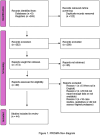Systematic review and meta-analysis of the pelvic organ prolapse and vaginal prolapse among the global population
- PMID: 39877583
- PMCID: PMC11771496
- DOI: 10.1002/bco2.464
Systematic review and meta-analysis of the pelvic organ prolapse and vaginal prolapse among the global population
Abstract
Background: Pelvic organ prolapse (POP) occurs when one or more pelvic organs (uterus, bowel, bladder or top of the vagina) descend from their normal position and bulge into the vagina. Symptoms include pelvic discomfort, fullness, and changes in bladder or bowel function. Treatment ranges from conservative approaches to surgery, depending on symptom severity. Surgical methods include vaginal wall repair, with or without hysterectomy, or via laparoscopic, robotic or open techniques. Common complications include bleeding, infection, and urinary or bowel dysfunction.
Methods: A systematic review was conducted, and a protocol was registered with PROSPERO (CRD42022346051). Publications from 30 April 1980 to 30 April 2023 were retrieved from multiple databases. Data were analysed using random-effects and common-effects models with subgroup and sensitivity analyses.
Findings: Forty-four studies met the inclusion criteria, with 29 studies used for meta-analysis of vaginal prolapse surgery outcomes. Sixteen studies focused on patients who had undergone hysterectomy alongside prolapse repair.
Interpretation: Patients who underwent vaginal prolapse surgery with hysterectomy experienced higher operative and postoperative complication rates than those without hysterectomy. Increased risks included hospital readmission, POP recurrence and re-operation. The review highlighted a lack of diversity in terms of ethnicity, age and comorbidity status, which are essential to fully understanding the impact of POP. Future research should focus on these underrepresented factors.
Keywords: gynaecology; pelvic organ prolapse; urology; wellbeing; women's health.
© 2024 The Author(s). BJUI Compass published by John Wiley & Sons Ltd on behalf of BJU International Company.
Conflict of interest statement
All authors report no conflict of interest. The views expressed are those of the authors and not necessarily those of the NHS, the National Institute for Health Research, the Department of Health and Social Care or the academic institutions.
Figures




References
-
- Haylen BT, Maher CF, Barber MD, Camargo SFM, Dandolu V, Digesu A, et al. An International Urogynaecology Association (IUGA) /International Continence Society (ICS) joint report on the terminology for female pelvic organ prolapse (POP). Int Urogynecol J. 2016;27(2):165–194. PMID: Erratum, 2016, 27(4): 655–684; Neurourol Urodyn, 2016, 35(2):137–168. - PubMed
-
- Ramesh B, Rani I, Rao KR. Uterovaginal Prolapse. In: Operations in Obstetrics and Gynecology: Text and Atlas. Jaypee Brothers Medical Publishers (P) Ltd; 2020;134–156. 10.5005/jp/books/18568 - DOI
-
- DeLancey J. Pelvic floor anatomy and pathology. In: Biomechanics of the female pelvic floor Elsevier; 2016. p. 13–51. 10.1016/B978-0-12-803228-2.00002-7 - DOI
Publication types
LinkOut - more resources
Full Text Sources
Miscellaneous
